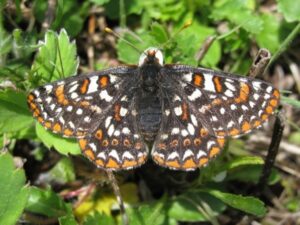Forgive the length of this post – it contains some big numbers!
This story is about Pacific Rim Institute for Environmental Stewardship (PRI). PRI is a Christ-centered nonprofit found south of Coupeville, WA for which I serve as board chair. PRI’s mission is engaging science, culture, and community for ecological healing through restoration, research, and conservation of prairies and other lands on Whidbey Island. We work through partnerships with local tribes, other environmental organizations, government agencies, churches, etc. and through education that equips servant leaders and provides various place-based services to the greater community. Our aim is to transform people and communities for environmental integrity, reconciliation, and justice. This is also a story about a once-endangered plant: the Golden Paintbrush plant!
Golden Paintbrush (Castilleja levisecta – CALE) is a species in the much larger genus Castilleja. CALE flowers are pale yellow, but those of other species vary from white, magenta, purple, red, orange and yellow. Unlike most species of plants, all paintbrush are hemi-parasitic with their roots connected to “host” plants of other species from which nutrient are taken. The hosts belong to a variety of species, but one of the most used locally is the Oregon sunshine, a daisy like plant which, like the Golden Paintbrush, is yellow.
The Golden Paintbrush was listed under the Endangered Species Act in 1997. The same year, a small 4-acre remnant of historic native prairie was discovered on what is now the PRI campus in Coupeville. When the paintbrush was listed, only 17,000 plants remained in ten small populations in British Columbia and Washington State. Four of the populations were on Whidbey Island.
Listing the Golden Paintbrush under the Endangered Species Act offered the opportunity (and legal requirement) for species recovery work to begin. In 2002, the Pacific Rim Campus of Au Sable Institute for Environmental Studies (now PRI) was chosen as a possible recovery site and a few young plants were outplanted near the prairie remnant. Those early plants flourished and were followed in 2006 with 100 additional plants followed by 991 plants in 2007, and 1030 in 2010. Many of these plants flourished and reproduced. The ESA goal of recovery at the PRI sites was 1000 plants that could sustain reproduction for five years. By 2016 the census count was 10,659. As the number of acres under restoration increased, so did the number of CALE. By 2023, restoration work had expanded to over 30 acres and the CALE census was 40,000 blooming plants. The year 2023 was a celebration year for PRI’s restoration effort with the announcement by the U.S. Fish and Wildlife service that Golden Paintbrush was being removed from the Endangered Species list. The success of PRI’s restoration played a critical part in that decision. The 2024 census of more than 91,000 plants made the PRI population the second largest population in the world!
 This early work was supported by government grants. Leadership from restoration scientists partnering with the staff at Pacific Rim provided the necessary expertise. The restoration effort soon expanded beyond the prairie remnant into the adjacent grassland dominated by European grasses and weeds. To provide the necessary infrastructure, a greenhouse, shade house, and propagation beds for the native prairie species were built. Spurred by the CALE work, more than 30 species of native plants are now being propagated at PRI, and the seed and plant sales of many of these species are an important income stream for PRI.
This early work was supported by government grants. Leadership from restoration scientists partnering with the staff at Pacific Rim provided the necessary expertise. The restoration effort soon expanded beyond the prairie remnant into the adjacent grassland dominated by European grasses and weeds. To provide the necessary infrastructure, a greenhouse, shade house, and propagation beds for the native prairie species were built. Spurred by the CALE work, more than 30 species of native plants are now being propagated at PRI, and the seed and plant sales of many of these species are an important income stream for PRI.
With the delisting of CALE from the Endangered Species Act, the availability of federal funds for continued restoration work on CALE also ended. But when one financial door closes, another has opened. The prairie at PRI has been identified as the ideal site for the reintroduction of the endangered Taylor’s Checkerspot butterfly, another prairie species!
 Ironically, the butterfly larva’s principal food source includes CALE — along with other species at PRI. Preparation research for the butterfly introduction is in progress with a tentative 2026 date for the first introductions at PRI and other sites on Whidbey Island. PRI is partnering with U.S. Fish and Wildlife, Washington’s Ecostudies Institute, and local tribes. The major hurdle for the introduction to cross will be the availability of grants through US Fish and Wildlife for the introductions. Earlier grants supported the Golden Paintbrush restoration work, but the current climate for new federal grants is looking bleak. Indeed, a current bill in congress, if passed, would significantly weaken the Endangered Species Act. It would still be illegal to kill a member of a listed species, but not to destroy its critical habitat. As PRI looks to the future, individual donors, churches, and tribal partners who believe in the work and mission of PRI will play an increasingly important role in supporting PRI’s work in prairie restoration.
Ironically, the butterfly larva’s principal food source includes CALE — along with other species at PRI. Preparation research for the butterfly introduction is in progress with a tentative 2026 date for the first introductions at PRI and other sites on Whidbey Island. PRI is partnering with U.S. Fish and Wildlife, Washington’s Ecostudies Institute, and local tribes. The major hurdle for the introduction to cross will be the availability of grants through US Fish and Wildlife for the introductions. Earlier grants supported the Golden Paintbrush restoration work, but the current climate for new federal grants is looking bleak. Indeed, a current bill in congress, if passed, would significantly weaken the Endangered Species Act. It would still be illegal to kill a member of a listed species, but not to destroy its critical habitat. As PRI looks to the future, individual donors, churches, and tribal partners who believe in the work and mission of PRI will play an increasingly important role in supporting PRI’s work in prairie restoration.
The Prairies on Whidbey Island historically were the garden for the local tribes. During the past few years, PRI has worked closely with the Coast Salish Youth Coalition (CSYC) to help them re-establish their critical cultural relationship with the land. This past May, more than 200 individuals representing about 10 local tribes returned for three days in a cultural celebration with their youth. PRI and the CSYC are working together on a sovereign food garden and plans are underway to expand this essential relationship!
The significance of this place as sacred ground is perhaps best shown in the short video recently produced by the Tulalip Tribe. https://www.tulalipcares.org/Video/VideoSectionPage?section=Pacific-Rim-Institute-for-Environmental-Stewardship&year=2024.
As the above story tells, the impact of PRI has been and continues to be felt both locally and beyond! We invite you to partner with us as stewards of this sacred place. Check out our website at www.PacificRimInstitute.org. for more information and opportunities. If you would like a personal tour of the facility, please let us know.
Our Prayer: Lord, as we daily walk in Your Kingdom, we pray for wisdom to bring healing to your broken Creation – both human and non-human. Amen
Thanks for caring!
— Joe Sheldon
Direct comments to Joe Sheldon at jksheldon43@gmail.com


